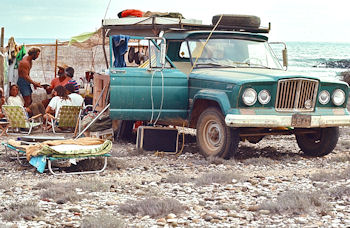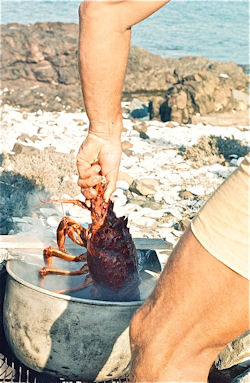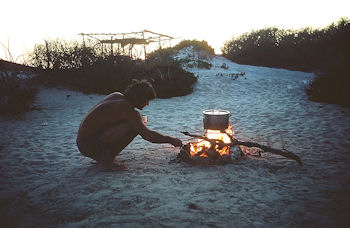 |  |
By Georgia Tanner

After a lobster burrito lunch and a visit with Señora Espinosa at her cafe in El Rosario, we’re ready to drive La Turquesa Grade, a steep, rocky switchback in 1971. Before dark our caravan of three trucks will stop for the night in the high desert. We have water and food for two weeks, gear for surfing and fishing, Gerhard & Gulick’s offroad guide, and beer to wash down the dust. One member of the caravan has encased his ice chest in surfboard foam and claims it will stay cold for ten days.
Tomorrow we will get gas at El Progreso, siphoned out of 50-gallon drums, then find the turnoff to a series of points known in that decade as the “Five Malibus.” Another day or two will get us to Punta Diablo, where we will set up camp and enjoy the freedom of a simple life. Fire, water, sky, and desert will become the elements of bliss during the rhythm of our days, which might go something like this: Wake up to silence or the sounds of birds and waves instead of machines. First light, time to build a fire in the ring of volcanic rocks, the kind that won’t explode in the heat. Put coffee water on the grate over the fire. Drink a cup or two as the rising sun reveals the size of the waves, the state of the wind, and whether coyotes found the fish scraps we threw out at dinner. “Voy a mi arbolito” [“I go to my little tree”] with shovel, TP, and matches. Morning light on desert hills invites another walk--head anywhere, there are no fences, and nature may bring a surprise like the one I saw after a hike to Punta Cono: two grey whales riding big waves. Weather permitting, there will be fishing and surfing, and wood-gathering before dark to avoid scorpions and snakes that might make their homes in a deadwood pile. At last, dinner around the fire. If the moon is dark there are constellations to explore, with the help of a star chart and a flashlight covered with red celophane to protect night vision. Finally, a good night’s sleep, and another morning to wake up happy, feeling at home on the earth.

The transpeninsular highway and many inland roads have been paved or graded since those classic days, but the elements of a good campsite can still be experienced, especially if previous campers have shown respect for the fragile nature of the desert and stayed on existing roads. The dry land retains tire tracks indefinitely, and low-growing plants feed and shelter wildlife and keep topsoil from blowing away in prevailing winds. Also, some species, such as the Least Tern, nest on the ground.
Preparation for an off-road trip hasn’t changed much. It’s still necessary to navigate--the Baja Atlas has updated topographic maps--and to travel with another vehicle; near our 1971 campsite a HELP sign made out of clam shells, partially dismantled so it could no longer be read from the air, was testimony to the dangers of a breakdown alone in an isolated spot. We carried peanut butter and other non-perishable food, a gallon of water per person per day, extra vehicle parts, and first-aid kits. And we had learned that the first rule of remote camping is awareness--stepping on cactus spines, a sharp shell, or a stringray can ruin a day, if not the trip. In 1976, during a summer at Scorpion Bay, my boyfriend Ray failed to do the “stingray shuffle” when he entered the water and got hit by a small but deadly diamond ray. Because the surf had just come up he didn’t get out of the water to soak his foot in hot salt water and leach out the poison, and the wound got infected. When it failed to heal, we took the advice of fisherman Jose Mesa and went into the village of San Juanico to meet his wife Rebecca, a curandera, or local healer. She looked at Ray’s foot and handed me a bunch of dried blossoms and leaves. "Guaco," she said. "Especial para vibora [snake] y pico de rayo [ray sting]." She told me to make a tea from the guaco and give it to Ray three times a day for three days. Guaco is a blood purifier and sedative that can be life-saving to someone bitten by a rattlesnake in a village that, at that time, was 100 miles off-road; it forestalls the panic which can pump venom quickly through the bloodstream and allows time to get the victim to a doctor and a shot of anti-venom. Guaco encouraged Ray to rest and give the wound time to heal.

The second rule of Baja camping might be leave nothing loose! Wind can come up in minutes, and whatever isn’t tied down takes flight. I can’t do without duct tape, bungee cords, rope, and shadecloth; a canopy or windbreak of shadecloth doesn’t rip like a tarp, and two layers make a privacy screen. Then the only problem becomes leaving that special place that has come to feel like home. And why not; living in tune with the elements was the guiding force in our everyday lives, the world we lived in for six million years.

Great policy and easy to get.

Great renewal process, if only south Dakota would do the same for car registration.

Very convenient, great price !!